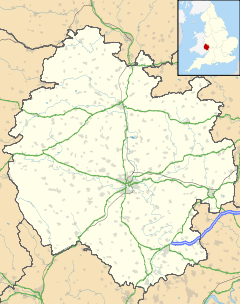- Cusop
-
Coordinates: 52°04′01″N 3°06′36″W / 52.067°N 3.110°W
Cusop
 Cusop shown within Herefordshire
Cusop shown within HerefordshirePopulation 300 (approx.) OS grid reference SO239415 Unitary authority Herefordshire Ceremonial county Herefordshire Region West Midlands Country England Sovereign state United Kingdom Post town HEREFORD Postcode district HR3 Dialling code 01497 Police West Mercia Fire Hereford and Worcester Ambulance West Midlands EU Parliament West Midlands UK Parliament Hereford and South Herefordshire List of places: UK • England • Herefordshire Cusop is a village and civil parish in Herefordshire, England that lies next to the town of Hay-on-Wye in Wales. It is reached by driving out of Hay towards Bredwardine, and turning right into Cusop Dingle.
The writer L.T.C. Rolt lived here between 1914 and 1922, in a house then known as Radnor View, in a development locally called "Thirty Acres". Spending his early boyhood here, he went on to co-found the Inland Waterways Association and the Talyllyn Railway Preservation Society, and to write many books on transport, engineering biography and industrial archaeology.
The village is recorded in Domesday Book as "Cheweshope".[1]
The Manor of Cusop formed part of the Ewyas Lacy Hundred and was once owned by the Clanowe Family, Edward III, Henry ap Griffith, Vaughans of Moccas and the Cornewall Family, lastly George Cornewall.[2]
Contents
Castles
There are two castles associated with the village. Cusop Castle and Mouse Castle, or Llygad.[3]
Cusop Castle is 200 yards from the church, formerly a fortified residence.[3][4]
Mouse Castle is an unfinished motte-and-bailey earthwork,[4] consisting of a rock boss with an artificially scarped vertical side.[5] The castle was held by the de Clanowe family in the 14th century.[2]
Cusop Dingle
Cusop Dingle is a wooded valley near the village. It is notable in entomological history as the place where the species Platypeza hirticeps was discovered in 1899.[6][7]
In the Dingle is a single track road, locally known as 'Millionaire's Row', because of the large, Victorian houses which line the route up to Offa's Dyke Path, one of the popular walking tracks in the West of England. It runs alongside the Dulas Brook (forming the border between Wales and England) into the foothills of the Black Mountains. With a multitude of waterfalls, the Dulas Brook is home to trout, otter and kingfishers.
Cusop Dingle was home to the poisoner Herbert Rowse Armstrong, the only English solicitor ever hanged for murder, and the grave of his wife Katharine is in the parish churchyard. His former home, originally Mayfield but now The Mantles, was owned by Martin Beales, a solicitor working in Armstrong's old office in Hay. Beales believed that Armstrong was innocent and published a book arguing his case.[8][9]
References
- ^ H. C. Darby; G. R. Versey (2008). Domesday Gazetteer. Domesday Geography of England. Cambridge University Press. p. 176. ISBN 052107858X.
- ^ a b Revd Charles John Robinson (1869). A history of the castles of Herefordshire and their lords. Longman and co. pp. 40–41.
- ^ a b John Duncumb (1812). Collections towards the history and antiquities of the county of Hereford. 2. Wright. pp. 236–237.
- ^ a b Pevsner, Nikolaus (1963). The Buildings of England - Herefordshire. New Haven and London: Yale University Press. pp. 109–110. ISBN 978-0300096095.
- ^ David James Cathcart King (1988). The castle in England and Wales: an interpretive history. Routledge. p. 53. ISBN 0918400082.
- ^ Radnorshire. Cambridge County Geographies. Cambridge University Press. p. 56.
- ^ Peter J. Chandler (2001). The flat-footed flies (Diptera: Opetiidae and Platypezidae) of Europe. Fauna entomologica Scandinavica. 36. Brill. pp. 223–225. ISBN 9004120238.
- ^ Beales, Martin (1997) The Hay Poisoner, London: Robert Hale Ltd, ISBN 0709061234
- ^ Beales' obituary in The Daily Telegraph
External links
 Media related to Cusop at Wikimedia CommonsCategories:
Media related to Cusop at Wikimedia CommonsCategories:- Herefordshire geography stubs
- Villages in Herefordshire
Wikimedia Foundation. 2010.

